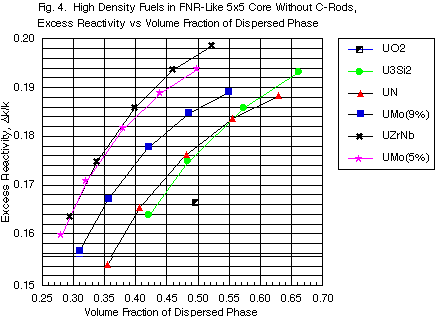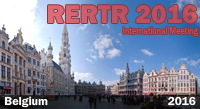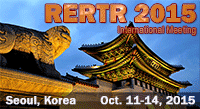ADVANCED LEU FUEL DEVELOPMENT
NEUTRONIC PERFORMANCE OF HIGH-DENSITY
LEU FUELS IN
WATER-MODERATED AND WATER-REFLECTED RESEARCH REACTORS
M. M. Bretscher and J. E. Matos
Argonne National Laboratory
9700 South Cass Avenue
Argonne, Illinois 60439
July 1996
![]() PDF version available
PDF version available
The text of this paper is provided below in HTML format and also in PDF format.
DOWNLOAD full paper in PDF format.
Introduction
At the Reduced Enrichment for Research and Test Reactors (RERTR) meeting in September
1994, Durand reported1 that the maximum uranium loading attainable with U3Si2
fuel is about 6.0 g U/cm3. The French Commissariat à l'Energie Atomique
(CEA) plan to perform irradiation tests with 5 plates at this loading. Compagnie pour
L'Etude et La Realisation de Combustibles Atomiques (CERCA) has also fabricated a few
uranium nitride (UN) plates with a uranium density in the fuel meat of 7.0 g/cm3
and found that UN is compatible with the aluminum matrix at temperatures below 500°C.
High density dispersion fuels proposed for development include U-Zr(4 wt%)-Nb(2 wt%), U-Mo(5 wt%), and U-Mo(9wt%). The purpose of this note is to examine the relative neutronic behavior of these high density fuels in a typical light water-reflected and water-moderated MTR-type research reactor.
Assumed Properties of the High Density Dispersion Fuels
Table 1 briefly summarizes the properties of these uranium dispersants. In this table,
rhoD is the density of the dispersant and WDU is the
weight fraction of uranium in the fuel particle. Since data is not available, it was
assumed that the porosity (P) dependance on the volume fraction of the dispersant in the
fuel meat (VFD) follows approximately the same relation as that found for U3Si2,
namely (see Ref. 2),
P = 0.072 VFD-0.275(VFD)2+1.32(VFD)3.
This relation accounts for the observed porosity of the UN test plates1.
Dispersant volume fractions corresponding to U3Si2 and UN fuel
plates with uranium loading of 6.0 and 7.0 g/cm3, respectively, are 53.1% and
51.9%. These values represent a practical upper limit for usable volume fractions. Figure
1 shows dispersant volume fractions as a function of uranium density in the fuel meat for
each fuel type. With a maximum volume fraction of 52-53%, this graph allows one to
estimate the maximum uranium density in the fuel meat that may be achieved for each fuel.
Fuel Element, Cross Sections, and Reactor Model
An 18-plate fuel element design, similar to that used in the University of Michigan's
Ford Nuclear Reactor (FNR) was used for this study. The fuel meat, Al-6061 clad, and water
channel thicknesses were assumed to be 0.020, 0.015, and 0.127 inch, respectively. Using
the WIMS code3, 4-group cross sections were generated for the fuel and for the
side plate regions for each uranium density and for each fuel type. The calculations were
made for LEU fuel with uranium densities in the fuel meat of 4.8, 5.5, 6.5, 7,5, and 8.5
g/cm3. At these densities the 235U fuel element masses are 3l7.8,
364.1, 430.3, 496.5, and 562.7 grams, respectively. The simplified hypothetical reactor
consisted of a square array of fuel elements immersed in a thick pool of water.
Calculations were made for 5x5 and 6x6 arrays of fresh fuel.
Results and Conclusions
For each fuel element array, core excess reactivities in % dk/k are plotted as a
function of uranium density for each dispersant. Figures 2 and 3 show these results. Data
for each plotted point are collected in Table 2 where VFM is the volume
fraction of the aluminum matrix. Figure 4 is a plot of excess reactivity vs volume
fraction of the dispersed phase for the 5x5 array. These results show that a dispersion of
the U-Zr-Nb alloy has the most favorable neutronic properties and offers the potential for
uranium densities greater than 8.0 g/cm3. On the other hand, UN is the least
reactive fuel because of the relatively large 14N(n,p) cross section. For a
fixed value of keff, the required 235U loading per fuel element is
least for the U-Zr-Nb fuel and steadily increases for the U-Mo(5%), U-Mo(9%), and UN
fuels. Because of volume fraction limitations, the UO2 dispersions are only
useful for uranium densities below 5.0 g/cm3. In this density range, however,
UO2 is more reactive than U3Si2.
Except for uranium mononitride, none of these proposed high density fuels have been
fabricated. Test results regarding the compatibility of UN and aluminum are reported in
Ref. 1, but no such data is currently available for the U-Mo and U-Zr-Nb alloys. How any
of these high density dispersion fuels behave under irradiation is also unknown. However,
all of these stabilize the uranium by inhibiting the formation of the alpha phase. FY 1996
funds have been provided to initiate the development, fabrication, and irradiation testing
of these high density fuels, especially the U-Zr-Nb alloy.
References
1. J. P. Durand, P. Laudamy, and K. Richter, "Preliminary Developments of MTR
Plates with Uranium Nitride," XVII International RERTR Meeting, Williamsburg,
Virginia, USA, September 18-23, 1994.
2. J. L. Snelgrove, R. F. Domagala, G. L. Hofman, T. C. Wiencek, G. L. Copeland, R. W.
Hobbs, and R. L. Senn, " The Use of U3Si2 Dispersed in Aluminum
in Plate-Type Fuel Elements for Research and Test Reactors," p. 11, ANL/RERTR/TM-11,
October 1987.
3. J. R. Deen, W. L. Woodruff and C. I. Costescu, "WIMS-D4M User Manual (Rev.
0)," ANL/RERTR/TM-23, Argonne National Laboratory, Argonne, IL, July 1995.
Table 1. Properties of Uranium Dispersants |
||
| Dispersant | rhoD -g/cm3 |
WUD -% |
| UO2 | 10.9 |
88.1 |
| U3Si2 | 12.2 |
92.7 |
| UN | 14.3 |
94.4 |
| U-Mo(9 wt.%) | 17.0 |
91.0 |
| U-Zr(4 wt.%)-Nb(2 wt.%) | 17.3 |
94.0 |
| U-Mo (5 wt.%) | 17.9 |
95.0 |
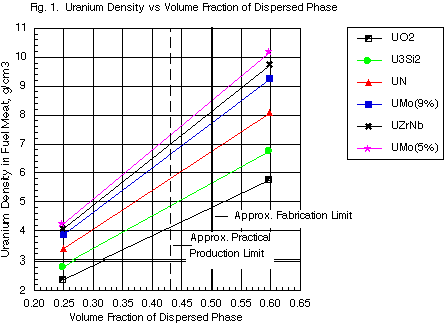
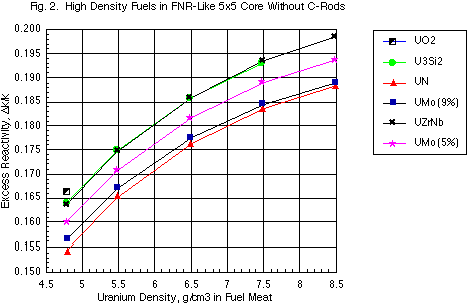
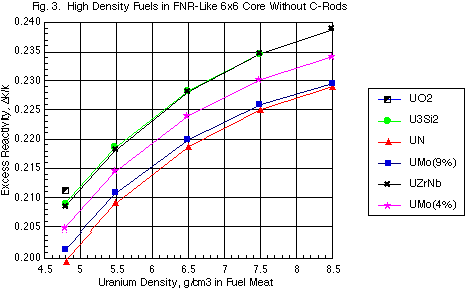
Table 2. Neutronic Performance of High-Density LEU Fuels in a H2O-Reflected Core |
||||||
| Dispersant | rhoU - g/cm3 |
VFD-% |
P-% |
VFM-% |
% dk/k |
|
6 x 6 Array |
5 x 5 Array |
|||||
| UO2 | 4.80 |
49.8 |
13.1 |
37.1 |
21.1 |
16.7 |
| U3Si2 | 4.80 5.50 6.50 7.50 |
42.4 48.6 57.5 66.3 |
8.2 12.2 20.1 31.2 |
49.4 39.2 22.4 2.50 |
20.9 21.9 22.8 23.5 |
16.4 17.5 18.6 19.3 |
| UN | 4.80 5.50 6.50 7.50 8.50 |
35.6 40.7 48.2 55.6 63.0 |
5.0 7.3 11.8 18.1 26.6 |
59.4 52.0 40.0 26.3 10.4 |
19.9 20.9 21.9 22.5 22.9 |
15.4 16.5 17.6 18.4 18.8 |
| U-Mo(9%) | 4.80 5.50 6.50 7.50 8.50 |
31.0 35.6 42.0 48.5 54.9 |
3.6 5.0 8.0 12.1 17.5 |
65.4 59.4 50.0 39.4 27.6 |
20.2 21.1 22.0 22.6 23.0 |
15.6 16.7 17.8 18.5 18.9 |
| U-Zr(4%)-Nb(2%) | 4.80 5.50 6.50 7.50 8.50 |
29.5 33.8 40.0 46.1 52.3 |
3.1 4.4 6.9 10.4 15.1 |
67.4 61.8 53.1 43.5 32.6 |
20.8 21.8 22.8 23.5 23.9 |
16.4 17.5 18.6 19.4 19.9 |
| U-Mo(5%) | 4.80 5.50 6.50 7.50 8.50 |
28.2 32.3 38.2 44.1 50.0 |
2.8 3.9 6.1 9.2 13.2 |
69.0 63.7 55.7 46.7 36.8 |
20.5 21.5 22.4 23.0 23.4 |
16.0 17.1 18.2 18.9 19.4 |
